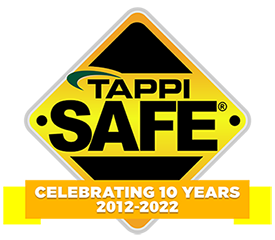 Search
Search
Use the search bar or filters below to find any TAPPI product or publication.
Filters
Publications
Level of Knowledge
Collections
Journal articles

Magazine articles

Impact and feasibility of a membrane pre-concentration step in kraft recovery, TAPPI Journal May 2021
ABSTRACT: Emerging robust membrane systems can perform the first section of black liquor (BL) concentration by separating clean water from the black liquor stream using only mechanical pressure. By doing so, they can reduce the steam and energy required for BL concentration. Because of the high osmotic pressure of strong BL, a membrane system would not replace evaporators but would operate in series, performing the first section of BL concentration. In this work, we use a multi-effect evaporator (MEE) model to quantify the steam and energy savings associated with installing membrane systems of different sizes. When maintaining a constant BL solids throughput, we find that a pulp mill could reduce steam usage in its evaporators by up to 65%. Alternatively, a membrane system could also serve to increase BL throughput of the recovery train. We find that a membrane system capable of concentrating BL to 25% could double the BL solids throughput of a mill’s evaporators at the same steam usage. We also demonstrate that installing a membrane system before an MEE would minimally affect key operating parameters such as steam pressures and BL solids concentrations in each effect. This indicates that installing a membrane pre-concentration system would be nonintrusive to a mill’s operations.
Journal articles

Magazine articles

Non-process elements in the recovery cycle of six Finnish kraft pulp mills, TAPPI Journal March 2023
ABSTRACT: In this work, the aim was to study the distribution and accumulation of the non-process elements (NPEs) in the recovery cycle of Finnish pulp mills and look at whether the geographical location (North vs. South) correlates with the current Finnish NPE levels. In addition, a comparison to older similar Finnish measurements was made with an attempt to analyze the reasons behind differences in the most typical non-process elements, aluminum (Al), silicon (Si), calcium (Ca), phosphorus (P), magnesium (Mg), manganese (Mn), chlorine (Cl), and potassium (K), taking into account the main elements in the white liquor, sodium (Na) and sulfur (S). The extensive laboratory results gained in this study are from seven sampling points at six pulp mills and present analytical data of metal concentrations. The data obtained presents an update to previous NPE studies. The levels found did not statistically differ between North and South Finland. The NPE levels, apart from phosphorus, found in Finnish pulp mills today have not changed considerably compared to the levels in earlier investigations in the 1990s. In the newest data, the phosphorus concentration was consistently higher in the as fired black liquor, electrostatic precipitator (ESP) ash, lime mud, and green liquor than in the previous results. In addition, the levels of Al, Si, Ca, P, and Mg in recovery boiler ESP ash were consistently higher compared to the older results. As the mills start to close their systems more, a stronger accumulation of NPEs can be expected, increasing the likelihood of more operational problems in the process. Further understanding of where the NPEs accumulate and how they can be most effectively removed will be valuable knowledge in the future.
Journal articles

Magazine articles

Three-dimensional visualization and characterization of paper machine felts and their relationship to their properties and dewatering performance, TAPPI Journal July 2021
ABSTRACT: Polymeric felts are commonly used in the papermaking process on the paper machine wet end, in the press section, and in the dryer section. They provide an important function during paper manufacturing, including as a carrier or support; as a filter media assisting with water removal on the paper machine; in retention of fibers, fines, and fillers; and in some applications, such as tissue and towel, to impart key structural features to the web. These felts can have highly interwoven complex internal structures comprised of machine direction and cross-machine direction yarns of varying sizes and chemical compositions. Here, we present a non-intrusive three-dimensional (3D) image visualization method using advanced X-ray computed tomography (XRCT). This method was used to characterize the complex 3D felt structure and determine the water removal characteristics of some commonly used paper machine felts. The structural features analyzed include porosity; specific pore-yarn interfacial surface area; 3D pore size distribution; 3D fiber or yarn-size distribution; and their variations through the thickness direction. The top, middle, and bottom layers of the felt have very different structures to assist with water removal and impart paper properties. The size distribution of the yarns, as well as the pores in the different layers of the felt, are also inherently different. These structural features were non-intrusively quantified. In addition, variation in the structural characteristics through the thickness of the felts and its potential role in papermaking is explored. In addition to the 3D structural characteristics, permeability characteristics and water removal characteristics, including rewetting of select felt samples, have also been experimentally determined. It is interesting to observe the relationship between key structural features and permeability and water removal characteristics. These relationships can provide additional insights into press felt design, as well as ways to improve product properties and the dewatering efficiency and productivity of the paper machine.
Journal articles

Magazine articles

A novel approach for determining the reactivity of dissolving pulp based on the COD method
ABSTRACT: A novel approach for determining the reactivity of dissolving pulp according to the chemical oxygen demand (COD) of water has been discussed. First, a sample of dissolving pulp was subjected to mercerization and xanthation in order to obtain dissolved cellulose fractions. Next, the fractions were digested with a testing solution as applied in COD procedures. Finally, the resulting liquid was rapidly tested by ultraviolet-visible spectrophotometry (UV-Vis). By quantifying the absorbance of Cr3+ at a wavelength of 600 nm, the reactivity of dissolving pulp was indirectly calculated. The results measured by this novel COD method correlated well with the most accepted Fock test results with less than 10% relative difference. Meanwhile, this newly developed COD method required less time-consuming procedures as compared to the Fock test.
Journal articles

Magazine articles

Application of ATR-IR measurements to predict the deinking efficiency of UV-cured inks, TAPPI Journal January 2022
ABSTRACT: In recent years, ultraviolet (UV)-curable ink has been developed and widely used in various printing applications. However, using UV-printed products (UV prints) in recovered paper recycling causes end-product dirt specks and quality issues. A new method was developed that can distinguish UV prints from other prints by means of attenuated total reflectance infrared (ATR-IR) spectroscopy. Application of this method could allow more efficient use of UV prints as raw materials for paper recycling.First, a mill trial was performed using UV prints alone as raw materials in a deinked pulp (DIP) process. Second, test prints were made with four types of UV inks: a conventional UV ink and three different highly-sensitive UV inks. Each print sample had four levels of four-color ink coverage patterns (100%, 75%, 50%, and 25%). Next, deinkability of all prints was evaluated by laboratory experiments. Finally, each print was measured using the ATR-IR method, and the relationship between the IR spectra and deinkability was investigated. Mill trial results showed that UV prints caused more than 20 times as many dirt specks as those printed with conventional oil-based ink. There were variations in recycling performance among UV prints taken from bales used for the mill trial. Lab tests clearly revealed that not all UV-printed products lead to dirt specks. In order to clarify the factors that affected deinkability of UV prints, the print samples were investigated by lab experiments. Key findings from lab experiments include: • The number of dirt specks larger than 250 µm in diameter increased as the ink coverage increased. • Higher ink coverage area showed stronger intensity of ATR-IR spectral bands associated with inks. These results indicate that deinkability of UV prints could be predicted by analysis of ATR-IR spectra. • Finally, the method was applied for assessment of recovered paper from commercial printing presses. It was confirmed that this method made it possible to distinguish easily deinkable UV prints from other UV prints. Based on these findings, we concluded that the ATR-IR method is applicable for inspection of incoming recovered paper.
Journal articles

Magazine articles

Continuous digester rapid thinning, TAPPI Journal June 2024
ABSTRACT: Carbon steel continuous digesters built after the early 1980s are fully stress relieved, so stress corrosion cracking has been less of a concern. However, these newer digesters were designed to run modified cooking processes that have turned out to be much more corrosive than those running with conventional cooking. This corrosion is mainly associated with softwood digesters and appears to be flow related. Average corrosion rates of 40 mil/year are possible on the exposed shell between the wash and extraction screens. The corrosion patterns are visually distinct from surfaces in the upper digester and below the wash screens. This paper goes into practical detail on where it occurs, the causes, visual identification, inspection planning and results evaluation, and finally, how to mitigate this damage, which consists of applying a corrosion resistant barrier. Some discussion on dealing with general corrosion throughout the digester is included.
Journal articles

Magazine articles

Dissolution of wood components during hot water extraction of spruce, TAPPI Journal May 2023
ABSTRACT: The purpose of this study was to investigate the autohydrolysis of softwood, which is the main chemical operation in both hot water extraction and steam explosion. Control of the process and monitoring its course were ensured by the careful choice of experimental setup and conditions: a milled spruce material was extracted in a small flow-through reactor to minimize degradation of the dissolved material and to enable analysis of the resulting liquors extracted at selected time points. The obtained liquid and solid fractions were analyzed for sugar composition and acetic acid concentration. The results showed that partially degraded hemicelluloses were extracted; hemicelluloses side chains were cleaved off and detected as monomers, while deacetylation was limited. Chain scissions of cellulose were observed as a result of autohydrolysis.
Journal articles

Magazine articles

Textiles: A New Door of Opportunity Opens, Paper360º November/December 2022
Journal articles

Magazine articles

World’s Most Northerly Paper Mill Makes Sustainable Choices, Paper360º January/February 2024
Journal articles

Magazine articles

TAPPI Journal Summaries, Paper360º November/December 2020
TAPPI Journal Summaries, Paper360º November/December 2020






